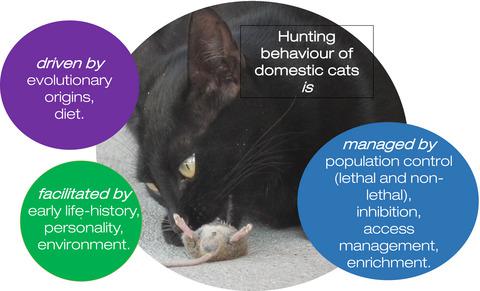当前位置:
X-MOL 学术
›
Mammal Rev.
›
论文详情
Our official English website, www.x-mol.net, welcomes your
feedback! (Note: you will need to create a separate account there.)
Drivers and facilitators of hunting behaviour in domestic cats and options for management
Mammal Review ( IF 4.3 ) Pub Date : 2020-12-15 , DOI: 10.1111/mam.12230 Martina Cecchetti 1 , Sarah L. Crowley 1 , Robbie A. McDonald 1
中文翻译:

家猫狩猎行为的驱动因素和促进因素以及管理选择
更新日期:2020-12-15
Mammal Review ( IF 4.3 ) Pub Date : 2020-12-15 , DOI: 10.1111/mam.12230 Martina Cecchetti 1 , Sarah L. Crowley 1 , Robbie A. McDonald 1
Affiliation

|
- Domestic cats Felis catus are distinct from other domesticated animals because their phenotype and genotype are relatively unchanged. While they live with people as pets or pest controllers, they retain capacity for survival independent of human support and readily persist as feral animals. Most cats retain some propensity to express hunting behaviours, even if hunting is not required for nutrition. In some settings, depredation by cats is a threat to biodiversity conservation, leading to attempts to mitigate their impacts.
- We characterise drivers and facilitators of the hunting behaviour of domestic cats: evolutionary origins, diet, life history, personality and environment. Hunting is driven particularly by evolutionary constraints and associated physiological and nutritional requirements. Proximate causes of variation in hunting behaviours relate to prey availability, husbandry and degree of domestication, while early life history and personality play further roles.
- We review cat management approaches in terms of effectiveness, feasibility and welfare. Amongst lethal, large-scale methods of population control, poisoning is most frequently used in cat eradications from islands. Because poisoning is challenged on welfare grounds, euthanasia is used at smaller scales and in inhabited, mainland settings. Non-lethal approaches, primarily surgical sterilisation, are favoured by cat advocates but entail challenging logistics and scale. In attempts to inhibit predation of wild species by pet cats, owners restrict outdoor access and use collar-mounted devices, including bells, sonic devices, collar covers and bibs. Other individual-level interventions, such as dietary and behavioural enrichment, some of which may improve cat welfare, have potential, but effects on hunting remain untested.
- Understanding and managing the hunting behaviour of cats are complex challenges. We highlight drivers and facilitators of this behaviour, representing starting points for formulating solutions that might be acceptable to cat owners and wider groups of people who value cat welfare, while also being effective for wildlife conservation.
中文翻译:

家猫狩猎行为的驱动因素和促进因素以及管理选择
- 家猫Felis catus不同于其他家养动物,因为它们的表型和基因型相对不变。虽然它们作为宠物或害虫控制者与人一起生活,但它们仍保持独立于人类支持的生存能力,并且很容易作为野生动物生存。大多数猫保留一些表达狩猎行为的倾向,即使狩猎不是营养所必需的。在某些情况下,猫的掠食是对生物多样性保护的威胁,导致试图减轻其影响。
- 我们描述了家猫狩猎行为的驱动因素和促进因素:进化起源、饮食、生活史、个性和环境。狩猎特别受到进化限制和相关生理和营养需求的驱动。狩猎行为变异的直接原因与猎物的可用性、饲养和驯化程度有关,而早期生活史和个性起着进一步的作用。
- 我们从有效性、可行性和福利方面审查猫管理方法。在致命的大规模人口控制方法中,中毒最常用于从岛屿上消灭猫。由于中毒受到福利方面的挑战,安乐死在较小规模和有人居住的大陆环境中使用。非致命方法,主要是手术绝育,受到猫倡导者的青睐,但需要具有挑战性的物流和规模。为了防止宠物猫捕食野生物种,主人限制户外活动并使用项圈安装装置,包括铃铛、声波装置、项圈套和围兜。其他个人层面的干预措施,例如饮食和行为丰富,其中一些可能会改善猫的福利,具有潜力,但对狩猎的影响仍未得到测试。
- 了解和管理猫的狩猎行为是一项复杂的挑战。我们强调这种行为的驱动因素和促进因素,代表制定解决方案的起点,这些解决方案可能为猫主人和更广泛的重视猫福利的人群所接受,同时对野生动物保护也有效。











































 京公网安备 11010802027423号
京公网安备 11010802027423号